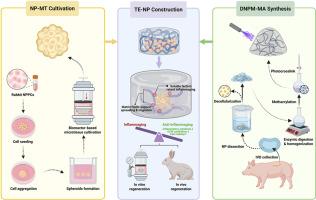Bottom-up engineering of the nucleus pulposus using a photocrosslinkable decellularized matrix hydrogel attenuates inflammaging and enhances microtissue-mediated regeneration
IF 10.2
1区 医学
Q1 ENGINEERING, BIOMEDICAL
引用次数: 0
Abstract
Degenerative disc disease (DDD), characterized by the pathological deterioration of nucleus pulposus (NP) tissue, affects millions globally. Tissue engineering strategies offer potential to create tissue-engineered NP (TE-NP) analogs to address DDD. However, traditional "top-down' approaches face challenges in achieving uniform cell distribution and replicating the intradiscal extracellular matrix (ECM) environment. In contrast, a "bottom-up' strategy utilizing microscale seed units represents a promising alternative. This study introduces an innovative "bottom-up' approach for constructing TE-NP, leveraging bioreactor-cultivated NP microtissues (NP-MTs) as seed units and a novel methacrylate-modified decellularized nucleus pulposus matrix (DNPM-MA) hydrogel as a supporting biomaterial. NP-MTs cultivated under low-magnitude hydrostatic pressure exhibit nascent ECM surroundings adapting well to the intradiscal microenvironment. The DNPM-MA hydrogel, with its compositional and mechanical attributes, supports the growth, migration, proliferation, and ECM synthesis of NP-MTs, making it an ideal biomaterial for long-term cultivation. The combination of NP-MTs and the DNPM-MA hydrogel yielded superior tissue regeneration outcomes both in vitro and in vivo. Transcriptome and molecular assessments revealed a correlation between the biological properties of the DNPM-MA hydrogel and the attenuation of inflammaging within encapsulated NP-MTs. Overall, this innovative "bottom-up' constructed TE-NP exhibits superior regenerative potential and is a promising tissue engineering strategy for treating DDD.

利用光交联脱细胞基质水凝胶对髓核进行自下而上的工程处理,可减轻炎症并增强微组织介导的再生
椎间盘退行性疾病(DDD)以髓核(NP)组织的病理性恶化为特征,影响全球数百万人。组织工程策略提供了创建组织工程NP (TE-NP)类似物来解决DDD的潜力。然而,传统的“自上而下”方法在实现均匀的细胞分布和复制椎间盘内细胞外基质(ECM)环境方面面临挑战。相比之下,利用微型种子单位的“自下而上”策略是一个有希望的选择。本研究介绍了一种创新的“自下而上”构建TE-NP的方法,利用生物反应器培养的NP微组织(NP- mts)作为种子单位,并利用新型甲基丙烯酸酯修饰的脱细胞髓核基质(DNPM-MA)水凝胶作为支撑生物材料。在低静水压力下培养的NP-MTs表现出新生的ECM环境,能够很好地适应盘内微环境。DNPM-MA水凝胶具有良好的组成和力学特性,支持NP-MTs的生长、迁移、增殖和ECM合成,是理想的长期培养生物材料。NP-MTs和DNPM-MA水凝胶的结合在体外和体内都产生了良好的组织再生效果。转录组和分子评估显示DNPM-MA水凝胶的生物学特性与包封np - mt内炎症的衰减之间存在相关性。总的来说,这种创新的“自下而上”构建的TE-NP具有优越的再生潜力,是治疗DDD的有前途的组织工程策略。
本文章由计算机程序翻译,如有差异,请以英文原文为准。
求助全文
约1分钟内获得全文
求助全文
来源期刊

Materials Today Bio
Multiple-
CiteScore
8.30
自引率
4.90%
发文量
303
审稿时长
30 days
期刊介绍:
Materials Today Bio is a multidisciplinary journal that specializes in the intersection between biology and materials science, chemistry, physics, engineering, and medicine. It covers various aspects such as the design and assembly of new structures, their interaction with biological systems, functionalization, bioimaging, therapies, and diagnostics in healthcare. The journal aims to showcase the most significant advancements and discoveries in this field. As part of the Materials Today family, Materials Today Bio provides rigorous peer review, quick decision-making, and high visibility for authors. It is indexed in Scopus, PubMed Central, Emerging Sources, Citation Index (ESCI), and Directory of Open Access Journals (DOAJ).
 求助内容:
求助内容: 应助结果提醒方式:
应助结果提醒方式:


